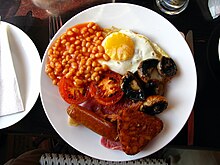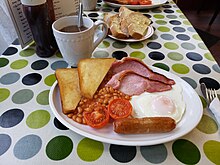Full breakfast

| Part of a series on |
| Meals |
|---|
 |
| Meals |
| Components andcourses |
| Related concepts |
Afull breakfastis a substantial cookedbreakfastmeal, often served inGreat BritainandIreland.The typical ingredients arebacon,sausages,eggs,black pudding,baked beans,tomatoes,mushroomsandfried breadwithtoastand a beverage such as coffee or tea served on the side.Hash brownsare a common contemporary but non-traditional inclusion. Ingredients may extend beyond these or include regional variants, which may often be referred to by different names depending on the area. While it is colloquially known as a "fry-up" in most areas of the United Kingdom and Ireland, it is usually referred to as a "full English" (often "full English breakfast" ),[1]a "full Irish", "full Scottish",[2]"full Welsh",[3]and "Ulsterfry ",[4]inEngland,theRepublic of Ireland,Scotland,Wales,andNorthern Ireland,respectively.
History and popularity[edit]
Many of the ingredients of a full breakfast have long histories, but "large cooked breakfasts do not figure in English life and letters until the 19th century, when they appeared with dramatic suddenness".[5]Across the British Isles and Ireland,early modernbreakfasts were often breads served with jams or marmalades, or else forms ofoatmeal,porridgeorpottage.[6]Eggs and bacon started to appear in breakfasts in the seventeenth century,[6]but they were not the only meats consumed in breakfasts at that time.[6]The rising popularity of breakfast was closely tied to the rise ofteaas a popular morning drink.[5]Of note were the lavish breakfasts of the aristocracy, which would centre on local meats and fish from their country estates.[5][7]
The fried breakfast became popular in Great Britain and Ireland during theVictorian era.Cookbooks were important in the fi xing of the ingredients of a full breakfast during this time,[5]and the full breakfast appeared in the best-sellingIsabella Beeton'sBook of Household Management(1861). This new full breakfast was a pared-down version of the country breakfasts of the upper-class, affordable to the emergent middle classes and able to be prepared and consumed in a shorter time before a day's work.[5][6][8]The full breakfast reached its peak of popularity inEdwardian Britain,[8]and despite a decline following the food shortages of World War II,[5]new technologies of food storage and preparation allowed it to become a staple of the working class in the 1950s.[8]Since then the full breakfast has reduced in popularity as a daily meal, due to perceived concerns about health and its lengthy preparation compared to convenience-food breakfasts.[5]However the meal remains popular as an occasional, celebratory or traditional breakfast.[5][8]
It is so popular in Great Britain and Ireland that manycafésandpubsoffer the meal at any time of day as an "all-day breakfast". It is also popular in manyCommonwealthnations. The full breakfast is among the most internationally recognisedBritish dishesalong withbangers and mash,shepherd's pie,fish and chips,roast beef,Sunday roast,cream teaand theChristmas dinner.[9]
United Kingdom and Ireland[edit]


Variants by country and region[edit]
England[edit]
There is no fixed menu or set of ingredients for a full breakfast.[5][8]A common traditional English breakfast typically includesback bacon[8][10][11]or sausages (usually pork),[8][10]eggs (fried,poachedorscrambled),[8][10][11]fried or grilled tomatoes,[8][10][11]fried mushrooms,[8][10][11]black pudding,[8][10][11]baked beans[8][11]andbread,either, or both,toastandfried bread.[12]Bubble and squeakis a traditional accompaniment but is now more commonly replaced byhash browns.[13]
A poll byYouGovin 2017 found the following to be on more than 50% of 'ideal' Full English breakfasts: bacon; sausage; beans; bread (either toast or fried); eggs (fried, scrambled or poached); hash browns; mushrooms (fried or grilled); and tomatoes (fried, grilled or tinned).[14]Black pudding was the least popular of the traditional ingredients, chosen 35% of the time,[14]and 26% of people included eitherchipsorsautéedpotatoes.[14]
Butteredtoast,andjamormarmalade,are often served at the end of the meal, although toast is generally available throughout the meal.[15]
As nearly everything is fried in this meal, it is commonly known as a "fry-up". In the UK it is sometimes referred to as a "Full Monty".One theory for the origin of this term is that British Army generalBernard Montgomery,nicknamed 'Monty', was said to have started every day with a "Full English" breakfast while on campaign in North Africa during the Second World War.[16][17]
Vegetarianorveganalternatives can be made or are available in cafes and restaurants.[18]Meat alternativesausages and bacon may often be used,[18][19][20]with either scrambledtofu[19][20]oregg substitutes.[20]The role of the mushroom and tomatoes is generally larger in these versions.[19][20]
Ireland[edit]

In Ireland, brownsoda bread,friedpotato farls,white puddingandboxtyare often included.[21]
The "breakfast roll",[22]consisting of elements of the full breakfast served in aFrench roll,has become popular in Ireland due to the fact it can be easily eaten on the way to school or work.[22]The breakfast roll is available from manypetrol stationsand corner shops throughout Ireland.[22]
Ulster[edit]

InUlster,the northernprovinceof Ireland, the "Ulster fry" variant is popular throughout the province chiefly inNorthern Ireland,parts ofCounty Donegal,northernCounty Monaghanand some parts of northernCounty Cavanwhere it is eaten not only at breakfast time but throughout the day. Typically it will includesoda breadfarlsandpotato bread.[23]
Scotland[edit]

InScotlandthere are some distinctivelyScottish elementsof the full breakfast which include Scottish style orStornoway black pudding,Lorne sausage(sometimes called "square sausage" for its traditional shape), Ayrshire middle bacon andtattie scones.Occasionallyhaggis,white pudding,fruit pudding[24]oroatcakesare included.[25][26][27]
Early editions ofBrewer's Dictionary of Phrase and Fablereferred to aScotch breakfastas "a substantial breakfast of sundry sorts of good things to eat and drink".[28]
Wales[edit]
Two key ingredients that distinguish theWelshbreakfast from the other "full" variations arecockles(Welsh:cocs) andlaverbread(Welsh:bara lafwr or bara lawr) (anedible seaweedpurée often mixed with oatmeal and fried).[29]Fried laver with cockles and bacon was the traditional breakfast for mine workers in theSouth Wales Coalfield,but a breakfast may have also included Welsh sausages, mushrooms and eggs.[3][30][31]
North America[edit]
This style of breakfast was brought over by Irish andBritishimmigrantsto the United States and Canada, where it has endured.[32]
Hong Kong[edit]
A few establishments inHong Kongoffer all-day breakfast or brunch options (hybrid of English and North American items) from formal restaurants to low-frills establishments.[33][34]
See also[edit]
References[edit]
- ^"The full English".Jamieoliver. Archived fromthe originalon 28 July 2014.Retrieved26 February2014.
- ^"Traditional Scottish Food".Visit Scotland. Archived fromthe originalon 13 February 2014.Retrieved26 February2014.
- ^ab"So what is a 'full Welsh breakfast'?".Wales Online.25 October 2005. Archived fromthe originalon 2 May 2014.
- ^Bell, James (29 January 2014)."How to... Cook the perfect Ulster Fry".Belfast Telegraph.Retrieved26 February2014.
- ^abcdefghiO’Connor, K. (2009). Cuisine, nationality and the making of a national meal: The English breakfast. In Nations and their histories: Constructions and representations (pp. 157-171). London: Palgrave Macmillan UK.
- ^abcdAnderson, H. A. (2013). Breakfast: a history. AltaMira Press.
- ^Shaw Nelson, Kay."The Gastronomic World of Sir Walter Scott".Electric Scotland.Retrieved3 August2023.
- ^abcdefghijkl"History Of The Traditional English Breakfast".English breakfast society.Retrieved21 October2021.
- ^Spencer, Colin (2003).British Food: An Extraordinary Thousand Years of History.Columbia University Press.ISBN978-0-231-13110-0.
- ^abcdef"Full English Breakfast Recipe".BBC.Retrieved17 March2022.
- ^abcdef"The Full English".Jamie Oliver. 29 March 2018.
- ^"EXCLUSIVE: Expert declares key ingredient doesn't belong in Full English for savage reason".Daily Mirror.12 April 2024.Retrieved10 June2024.
- ^"Bubble and shriek! Why war has been declared on the humble hash brown".The Guardian.3 April 2023.Retrieved3 August2023.
- ^abc"Breakfast"(PDF).YouGov.Retrieved3 August2023.
- ^"How to make the perfect full English breakfast".25 June 2015.
- ^Parkinson, Judy (2011).Spilling the Beans on the Cats Pyjamas: Popular Expressions – What They Mean and Where We Got Them.Michael O'Mara Books
- ^Dent, Susie (2009).What Made The Crocodile Cry?: 101 questions about the English language.Oxford University Press. pp. 151–152.ISBN9780191650604.
- ^ab"Wetherspoons launches full English breakfast for vegans".Vegan Food and Living. 5 October 2018.Retrieved4 August2023.
- ^abcNice, Miriam."Vegan fry-up".BBC Good Food.Retrieved4 August2023.
- ^abcd"Vegan Traditional Full English Breakfast".The Edgy Veg. 15 October 2019.Retrieved4 August2023.
- ^Gerald, Paul (12 July 2012)."The Full English".Memphis Flyer.Contemporary Media, Inc.Retrieved30 July2012.
The Irish might have soda bread, a potato pancake called boxty, white pudding (what you're used to, but with oatmeal in it) or black pudding (the same, but with blood cooked in).
- ^abcMcDonald, Brian (12 May 2008)."Top breakfast baguette rolls into Irish history".Irish Independent.Retrieved30 July2012.
- ^"Is the Ulster fry the best cooked breakfast in the UK?".BBC. Retrieved 29 October 2018Archived24 June 2019 at theWayback Machine
- ^Gerald, Paul (12 July 2012)."The Full English".Memphis Flyer.Contemporary Media, Inc.Retrieved30 July2012.
The Scots like to have tattie (potato) scones, fruit pudding (actually a sausage made with very little fruit), and, of course, their curse on the earth, haggis.
- ^Foyster, Elizabeth and Whatley, Christopher A. (2009).A History of Everyday Life in Scotland, 1600 to 1800.Edinburgh University Press. p. 139.ISBN978-0748621576.
{{cite book}}:CS1 maint: multiple names: authors list (link) - ^Davidson, Alan and Jaine, Tom (2006).The Oxford companion to food.Oxford University Press. p. 185.ISBN0192806815.
{{cite book}}:CS1 maint: multiple names: authors list (link) - ^Maw Broon's Cookbook.Waverley Books. 18 October 2007. p. 18.ISBN978-1-902407-45-6.
- ^Brewer, E. Cobham.Brewer's Dictionary of Phrase & Fable.New York: Harper & Brothers. p. 812.
- ^"This is how to cook the perfect full Welsh breakfast".Wales Online.Retrieved6 August2019.
- ^Welsh Government."Wales – Food".Government of Wales.Archived fromthe originalon 1 June 2012.Retrieved30 July2012.
Laverbread, not actually bread at all but seaweed, is rolled in oatmeal, fried into crisp patties and served with eggs, bacon and fresh cockles for a traditional Welsh breakfast.
- ^Rodenas, Angeles (13 July 2021)."Welsh caviar: should we all start eating laver?".TheGuardian.Retrieved13 July2021.
- ^"The Full English Breakfast Hops the Pond".The Wall Street Journal.Retrieved 21 February 2018
- ^"Hong Kong brunch: 10 best bargain all-day breakfasts".scmp.Archived fromthe originalon 21 June 2017.Retrieved26 January2017.
- ^"Hong Kong's best-kept secrets: all-day breakfasts for HK$48 in a sleepy border village".scmp.6 April 2016.
Reference bibliography[edit]
- O'Connor, Kaori (2013).The English Breakfast: The Biography of a National Meal, with Recipes.Bloomsbury.ISBN978-0857854919.
- Scotney, John (1 November 2009).Scotland - Culture Smart!: The Essential Guide to Customs & Culture.Kuperard.ISBN9781857336214.
External links[edit]
 Media related toFull breakfastat Wikimedia Commons
Media related toFull breakfastat Wikimedia Commons The dictionary definition offull breakfastat Wiktionary
The dictionary definition offull breakfastat Wiktionary Cookbook:English Breakfastat Wikibooks
Cookbook:English Breakfastat Wikibooks- Stress-free full English breakfast
- Why the great British breakfast is a killer(subscription required)
